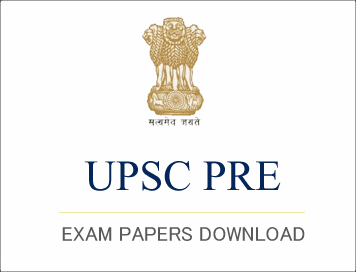(HOT) UPSC Current Affairs 2025 PDF
NEW! The Gist (NOV-2025) | E-BOOKS
(Paper) UPSC: Civil Service Prelims 2011 CSAT (Paper -2)
UPSC: Civil Service Prelims 2011
CSAT
(Paper-II)
- Time Allowed: Two Hours
- Maximum Marks: 200
PAGE - 1
Directions for the following 4 (four) items :
Read the following passage and answer the items that follow. Your answers to these items should be based on the passage only.
Passage:
A country under foreign domination seeks escape from the present in dreams of a vanished age, and finds consolation in visions of past greatness. That is a foolish and dangerous pastime in which many of us indulge. An equally questionable practice for us in India is to imagine that we are still spiritually great though we have come down in the world in other respects. Spiritual or any other greatness cannot be founded on lack of freedom and opportunity, or on starvation and misery. Many western writers have encouraged that notion that Indians are other-worldly. I suppose the poor and unfortunate in every country become to some extent other-worldly, unless they become revolutionaries, for this world is evidently not meant for them. So also subject peoples.
As a man grows to maturity he is not entirely engrossed in, or satisfied with, the external objective world. He seeks also some inner meaning, some psychological and physical satisfactions. So also with peoples and civilizations as they mature and grow adult. Every civilization and every people exhibit these parallel streams of an external life and an internal life. Where they meet or keep close to each other, there is an equilibrium and stability. When they diverge conflict arises and the crises that torture the mind and spirit.
1. The passage mentions that "this world is evidently not meant for them". It refers to people who
1. seek freedom from foreign domination.
2. live in starvation and misery.
3. become revolutionaries.
1. Which of the statements given above is/are correct ?
(a) 1 and 2 (b) 2 only
(c) 2 and 3 (d) 3 only
Ans. (a)
Sol: People who turn revolutionary are not ‘other wordly’ unless word shows the contradiction, hence 1
& 2.
2. Consider the following assumptions :
1. A country under foreign domination cannot indulge in spiritual pursuit.
2. Poverty is an impediment in the spiritual pursuit.
3. Subject peoples may become other-worldly.
With reference to the passage, which of the above assumptions is/are valid ?
(a) 1 and 2 (b) 2 only
(c) 2 and 3 (d) 3 only
Ans. (c)
Sol: For achieving anything great one has to be free of worries of basic needs. Secondly he/she should
be mentally as well as physically free. Hence 2 & 3.
3. The passage thematically centres on(a) the state of mind of oppressed people
(b) starvation and misery
(c) the growth of civilization
(d) body, mind and spirit of people in general
Ans. (a)
Sol: The passage revolves around the condition as they cannot dream of freedom or aspire for any kind
of opportunity. Starvation & misery come under that only. C & D are irrelevant.
4. According to the passage, the torture of the mind and spirit is caused
(a) by the impact of foreign domination.
(b) by the desire to escape from foreign domination and find consolation in visions of past greatness.
(c) due to lack of equilibrium between an external life and an internal life.
(d) due to one's inability to be either revolutionary or other
Ans. (c)
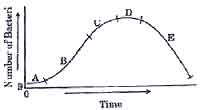 Sol.: The conflict between two arises when there is no balanceDirections for the following 3 (three) items:
Sol.: The conflict between two arises when there is no balanceDirections for the following 3 (three) items:
Read the passage given below, study the graph that follows and answer the three items given below the figure. During a party, a person was exposed to contaminated water. A few days later, he developed fever and loose motions. He suffered for some days before going to a doctor for treatment. On starting the treatment, he soon became better and recovered completely a few days later. The following graph shows different phases of the person's disease condition as regions A, B, C, D and E of the curve.
5. Which region/regions of the curve correspond/corresponds to
(a) A only
(b) B only
(c) B and C
(d) No part of the curve indicates the incubation phase
Ans. (a)
Sol: As incubation period is defined as the time from the infection enters the body to the time symptoms are manifested. So the answer has to be A.
6. Which region of the curve indicates that the person began showing the symptoms of infection ?
(a) A
(b) B
(c) C
(d) D
Ans. (b)
Sol: Since the region B is clearly indicating the time when the symptoms are developing in the body, the answer has to be B. other-worldly. – the concluding lines.
7. Which region of the curve indicates that the treatment yielded effective relief ?
(a) C
(b) D
(c) E
(d) The curve does not indicate the treatment
Ans. (c)
Sol: As the question talks about effective relief only the region E can denote it. So the answer is C.
8. There are four routes to travel from city A to city B and six routes from city B to city C. How many routes are possible to travel from the city A to city C ?
(a) 24
(b) 12
(c) 10
(d) 8
Ans. (a)
Study Kit : UPSC - IAS PRE (GS+CSAT) Solved Papers & Test Series
Printed Study Material for IAS (UPSC) General Studies PRE Cum MAINS
Sol: Since, there are 4 routes from A to B and 6 routes from B to C, number of ways need to be multiplied for finding number of routes from A to C. Thus, total number of routes is 4×6 = 24 .
9. A contract on construction job specifies a penalty for delay in completion of the work beyond a certain date is as follows : Rs. 200 for the first day, Rs. 250 for the second day, Rs. 300 for the third day etc., the penalty for each succeeding day being Rs. 50 more than that of the preceding day. How much penalty should the contractor pay if he delays the work by 10 days ?
(a) Rs. 4950 (b) Rs. 4250
(c) Rs. 3600 (d) Rs. 650
Ans. (b)
Sol: This is an AP wherein First Term = 200 Common difference = 50 Number of terms = 10 So, sum of these terms will be =10 n/2(2a+(n-l)d)=10/2x(2x200+9x50)=Rs4250
10. Consider the following figure and answer the item that Follows:
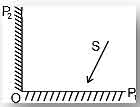
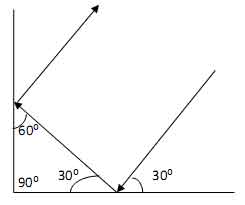 In the figure shown above, OP1 and OP2 are two plane mirrors kept perpendicular to each other, S is the direction of a beam of light falling on the mirror OP1 The direction of the reflected beam of light from the mirror OP2 will be:
In the figure shown above, OP1 and OP2 are two plane mirrors kept perpendicular to each other, S is the direction of a beam of light falling on the mirror OP1 The direction of the reflected beam of light from the mirror OP2 will be:
(a) Perpendicular to the direction S.
(b) At 45° to the direction S.
(c) Opposite and parallel to the direction S.
(d) At 60° to the direction S.
Ans. (c)
Sol: According to laws of reflection, we will get the following figure.
11. Consider the figure given below and answer the item that follows :
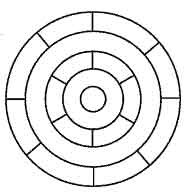
What is the minimum number of different colours required to paint the figure given above such that no two adjacent regions have the same colour ?
(a) 3 (b) 4
(c) 5 (d) 6
Ans. (a)
Sol: Refer the figure given, there will be only three colours required to fill the figure with the given conditions.
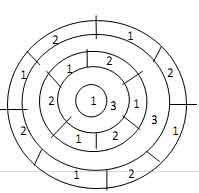
12. Consider the following figure and answer the item that follows:
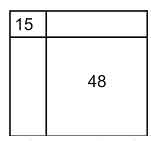
A square is divided into four rectangles as shown above. The lengths of the sides of rectangles are natural numbers. The areas of two rectangles are indicated in the figure. What is the length of each side of the square ?
(a) 10
(b) 11
(c) 15
(d) Cannot be determined as the given data are insufficient
Ans. (b)
Sol: We have to look for factors of 15 and 48 which have same difference. By hit and trial, we realize that 6×8 = 48 and 3×5 =15. Thus two sides have to be 3+8 =11 or 6 + 5 =11.
Directions for the following 8 (eight) items :
Read each of the following two passages and answer the items thai follow. Your answers to these items should be based on the passages only.
Passage:1
For achieving inclusive growth there is a critical need to rethink the role of the State. The early debate among economists about the size of the Government can be misleading. The need of the hour is to have an enabling Government. India is too large and complex a nation for the State to be able to deliver all that is needed. Asking the Government to produce all the essential goods, create all the necessary jobs, and keep a curb on the prices of all goods is to lead to a large cumbersome bureaucracy and widespread corruption.The aim must be to stay with the objective of inclusive growth that was laid down by the founding fathers of the nation and also to take a more modern view of what the State can realistically deliver. This is what leads to the idea of an enabling State, that is, a Government that does not try to directly deliver to the citizens everything that they need. Instead, it (1) creates an enabling ethos for the market so that individual enterprise can flourish and citizens can, for the most part, provide for the needs of one another, and (2) steps in to help those who do not manage to do well for themselves, for there will always be individuals, no matter what the system, 'who need support and help. Hence we need a Government that, when it comes to the market, sets effective, incentive-compatible rules and remains on the sidelines with minimal interference, and, at the same time, plays an important role in directly helping the poor by ensuring that they get basic education and health services and receive adequate nutrition and food.
13. According to the passage :
1. The objective of inclusive growth was laid down by the founding fathers of the nation.
2. Need of the hour is to have an enabling Government.
3. The Government should engage in maximum interference in market processes.
4. There is a need to change the size of the Government.
Which of the statements given above are correct ?
(a) 1 and 2 only
(b) 2 and 3 only
(c) 1 and 4 only
(d) 1, 2, 3 and 4
Sol: a, b and c cannot be the message. The only sentence that talks of a message is ‘d’ which is the main idea of the passage.
Passage:2
The concept of 'creative society' refers to a phase of development of a society in which a large number of potential contradictions become articulate and active. This is most evident when oppressed social groups get politically mobilised and demand their rights. The upsurge of the peasants and tribals, the movements for regional autonomy and self-determination, the environmental movements, and the women's movements in the developing -eountries are signs of emergence of creative society in contemporary times. The forms of social movements and their intensity may vary from country to country and place to place within a country. But the very presence of movements for social transformation in various spheres of a society indicates the emergence of a creative society in a country.
18. What does the author imply by "creative society" ?
1. A society where diverse art forms and literary writings seek incentive.
2. A society where social inequalities are accepted as the norm.
3. A society where a large number of contradictions are recognised.
4. A society where the exploited and the oppressed groups grow conscious of their human rights and upliftment.
Select the correct answer using the codes given below :
(a) 1, 2 and 3 (b) 4 only
(c) 3 and 4 (d) 2 and 4
Ans. (c)
Sol: Art forms (1) is not mentioned. Social inequalities (2) are not accepted. Only 3 & 4 are mentioned. Hence the answer ‘c’ is correct.
19. What according to the passage are the manifestations of social movements ?
1. Aggressiveness and being incendiary.
2. Instigation by external forces.
3. Quest for social equality and individual freedom.
4. Urge for granting privileges and self-respect to disparaged sections of the society.
Select the correct answer using the codes given below :
(a) 1 and 3 only (b) 2 and 4 only
(c) 3 and 4 only (d) 1, 2, 3 and 4
Ans. (b)
Sol: External forces — politically mobilized, ‘self-respect to sections of society’ is what creative society stands for, Aggression & ‘individual freedom’ do not fall under their norms. Hence (b).
20. With reference to the passage, consider the following statements :
1. To be a creative society, it is essential to have a variety of social movements.
2. To be a creative society, it is imperative to have potential contradictions and conflicts.
Which of the statements given above is/are correct ?
(a) 1 only (b) 2 only
(c) Both 1 and 2 (d) Neither 1 nor 2
Ans. (c)
Sol: Both variety of social monuments and potential contradictions are the pre requisites, hence ‘c’.
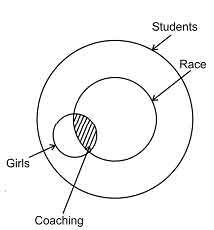 21. Consider the following three statements :
21. Consider the following three statements :
1. Only students can participate in the race.
2. Some participants in the race are girls.
3. All girl participants in the race are invited for coaching.
Which one of the following conclusions can be drawn from the above statements ?
(a) All participants in the race are invited for coaching.
(b) All students are invited for coaching.
(c) All participants in the race are students.
(d) None of the statements (a), (b) and (c) given above is correct.
Ans. (c)
Sol: From 1 it is clear that all the participants in the race are students.
Directions for the following 2 (two) items : Each of the following two items consists of four statements. Of these four statements, two cannot both be true, but both can be false. Study the statements carefully and identify the two that satisfy the above condition. Select the correct answer using the codes given below each set of statements :
22. Examine the following statements :
1. All animals are carnivorous.
2. Some animals are not carnivorous.
3. Animals are not carnivorous.
4. Some animals are carnivorous.
Codes :
(a) 1 and 3 (b) 1 and 2
(c) 2 and 3 (d) 3 and 4
Ans. (a)
Sol: Working with the options, we will realize that Statements “All animals are carnivorous” and “Animals are not carnivorous” cannot be true together; as if one of the statements is true then the other is obviously false. But there is a situation where in both the statements are false that is if some of the animals are carnivorous and some are not.
23. Examine the following statements :
1. All trains are run by diesel engine.
2. Some trains are run by diesel engine.
3. No train is run by diesel engine.
4. Some trains are not run by diesel engine.
Codes :
(a) 1 and 2 (b) 2 and 3
(c) 1 and 3 (d) 1 and 4
Ans. (c)
Sol: Working with the options, we will realize that Statements “All trains are run by diesel engine” and “No trains is run by diesel engine” cannot be true together; as if one of the statements is true then the other is obviously false. But there is a situation where in both the statements are false that is if some of the trains run on diesel engine and some are not.
24. Consider the four age pyramids given below namely A, B, C and D representing four different countries.{IMAGE}Which one of them indicates the declining population ?
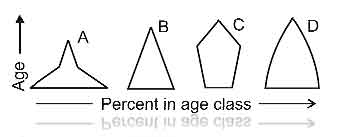
(a) A (b) B
(c) C (d) D
Ans. (c)
Sol: Declining population is denoted by greater no. of old aged people i.e. broader upper part of the pyramid and low population o youth and children i.e. narrow base. Both these conditions are being satisfied by the figure C 25. The following figure has four curves namely A, B, C and D. Study the figure and answer the item that follows.
25. Which curve indicates the exponential growth ?
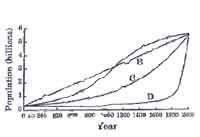
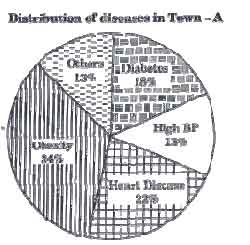 (a) A (b) B
(a) A (b) B
(c) C (d) D
Ans. (d)
Sol: Exponential growth is one whose initial growth is slow and then it picks up very fast and then growth increases very much. Thus graph D shows the exponential growth.
Directions for the following 2 (two) items: {IMAGE} The following pie charts show the break the patients from two towns, Town A and Town B. Pie charts plot the disease categories as percentage of the total number of patients. Based on these answer the two items that follow the charts
26. Which of the two towns has a higher number of persons with Diabetes ?
(a) Town A
(b) Town B
(c) Same in Town A and Town B
(d) No inference can be drawn
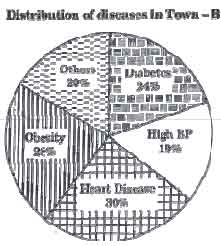 Ans. (d)
Ans. (d)
Sol: The population of the two towns is not known. Hence, no inference can be drawn.
27. What can we say about persons with more than one disease from these graphs ?
(a) There are likely to be persons with more than one disease in Town A.
(b) There are likely to be persons with more than one disease in Town B.
(c) There are likely to be persons with more than one disease in both Towns A and B.
(d) No inference can be drawn.
Ans. (b)
Sol: The sum of the distribution of diseases in Town – A comes out to be 100 but that in Town – B comes out to be 121%. So, there are likely to be be persons with more than one disease in Town – B.
28. Consider the following Velocity — Time graph. It shows two trains starting simultaneously on parallel tracks. With reference to the above graph, which one of the following statements is not correct ?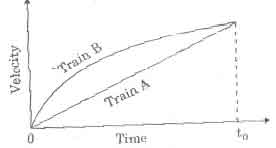
(a) Train B has an initial acceleration greater than that of Train A.
(b) Train B is faster than Train A at all times.
(c) Both trains have the same velocity at time t0.
(d) Both trains travel the same distance in time t0 units.
Ans. (d)
Sol: Statements (a), (b) and (c) are correct. The distance is the area of the graph below the Time-Velocity curve. In the two curves, the area of Train B curve is more than the area of the Train A curve. Hence, Train B covered more distance than train A.
Directions for the following 5 (five) items: Read the following passage and answer the items that follow. Your answers to these items should be based on the passage only.
Passage:
Now India's children have a right-to receive at least eight years of education, the gnawing question is whether it will remain on paper or become a reality. One hardly needs a reminder that this right is different from the others enshrined in the Constitution, that the beneficiary – a six year old child cannot demand it, nor can she or he fight a legal battle when the right is denied or violated. In all cases, it is the adult society which must act on behalf of the child. In another peculiarity, where a child's right to education is denied, no compensation offered later can be adequate or relevant. This is so because childhood does not last. If a legal battle fought on behalf of a child is eventually won, it may be of little use to the boy or girl because the opportunity missed at school during childhood cannot serve the same purpose later in life. This may be painfully true for girls because our society permits them only a short childhood, if at all. The Right to Education (RTE) has become law at a point in India's history when the ghastly practice of female infanticide has resurfaced in the form of foeticide. This is "symptomatic of a deeper urmoil" in society which is compounding the traditional obstacles to the education of girls. Tenacious prejudice against the intellectual potential of girls runs across our cultural diversity and the system of education has not been able to address it.
29. With reference to the passage, consider the following statements :
1. When children are denied education, adult society does not act on behalf of them.
2. Right to Education as a law cannot be enforced in the country.
Which of the statements given above is/are correct ?
(a) 1 only (b) 2 only
(c) Both 1 and 2 (d) Neither 1 nor 2
Ans. (a)
Sol: Adult society does not act because its of ‘no use’, hence correct. But RTE can be enforced, hence wrong.
30. According to the passage, what could be the traditional obstacles to the education of girls ?
1. Inability of parents to fight a legal battle when the Right to Education is denied to their children.
2. The traditional way of thinking about girls' role in society.
3. The prejudice against the intellectual potential of girls.
4. Improper system of education.
Select the correct answer from the codes given below :
(a) 1 and 2 only (b) 2, 3 and 4 only
(c) 1, 3 and 4 only (d) 1, 2, 3 and 4
Ans. (b)
Sol: ‘b’ is correct, As 2 and 3 are absolutely at par with the conditions prevailing and 4 is the faulty education system. So, all 2, 3 & 4 are correct.
31. On the basis of the passage, consider the following statements :
1. Right to Education is a legal right and not a fundamental right.
2. For realising the goal of universal education, the education system in the country must be made identical to that of developed countries.
Which of the statements given above is/are correct ?
(a) 1 only (b) 2 only
(c) Both 1 and 2 (d) Neither 1 nor 2
Ans. (a)
Sol: We all know Right to Education is fundamental right but according to the passage ‘it is different from others”. Ans. 2 is irrelevant as developed countries have not been mentioned.
32. Which one of the following statements conveys the key message of the passage ?
(a) India has declared that education is compulsory for its children.
(b) Adult society is not keen on implementing the Right to Education.
(c) The Right to Education, particularly of a girl child, needs to be safeguarded.
(d) The system of education should address the issue of Right to Education.
Ans. (c)
Sol: ‘This must be painfully true for girls’. This is the only choice among the answers that conveys the whole message.
33. Which one of the following statements conveys the inference of the passage ?
(a) The society has a tenacious prejudice against the intellectual potential of girls.
(b) Adults cannot be relied upon to fight on behalf of children for their Right to Education.
(c) The legal fight to get education for children is often protracted and prohibitive.
(d) There is no sufficient substitute for education received in childhood.
Ans. (a)
Sol: Since girl education is the key massage it has to be ‘a’ as ‘prejudice against potential of girls’ is the concern of the author.
Read the following passage and answer the 3 (three) items that follow :
A, B, C, D and E are members of the same family. There are two fathers, two sons, two wives, three males and two females. The teacher was the wife of a lawyer who was the son of a doctor. E is not a male, neither also a wife of a professional. C is the youngest person in the family and D is the eldest. B is a male.
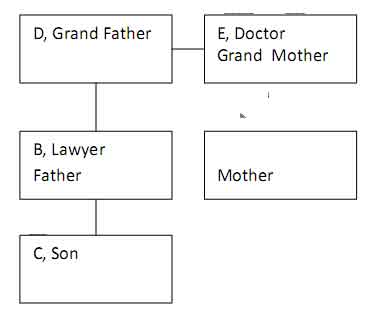 34. How is D related to E ?
34. How is D related to E ?
(a) Husband (b) Son
(c) Father (d) Wife
Ans. (a)
35. Who are the females in the group ?
(a) C and E (b) C and D
(c) E and A (d) D and E
Ans. (c)
36. Whose wife is the teacher ?
(a) C (b) D
(c) A (d) B
Ans. (b)
Read the following passage and answer the 3 (three) items that follow : In a survey regarding a proposed measure to be introduced, 2878 persons took part of which 1652 were males. 1226 persons voted against the proposal of which 796 were males. 1425 persons voted for the proposal. 196 females were undecided.
Solution for 37 to 39:
| Total=2878 | |||||
| Male=1652 | Female=1226 | ||||
| For=829 | Against=796 | Undecided=31 | For=600 | Against=430 | Undecided=196 |
37. How many females voted for the proposal ?
(a) 430 (b) 600
(c) 624 (d) 640
Ans. (b)
38. How many males were undecided ?
(a) 31 (b) 227
(c) 426 (d) 581
Ans. (a)
39. How many females were not in favour of the proposal ?
(a) 430 (b) 496
(c) 586 (d) 1226
Ans. (a)
40. In a queue, Mr. X is fourteenth from the front and Mr. Y is seventeenth from the end, while Mr. Z is exactly in between Mr. X and Mr. Y. If Mr. X is ahead of Mr. Y and there are 48 persons in the queue, how many persons are there between Mr. X and Mr. Z ?
(a) 6 (b) 7
(c) 8 (d) 9
Ans. (c)
Sol: Since, there are 48 students. Rank of X from front is 14 and rank of y is 32 from front. Thus rank of Z will be 32+14/2=23 Thus, number of students inbetween X and Z is 23−14 −1 = 8 .
Directions for the following 6 (six) items : Read each of the following two passages and answer- the items that follow. Your answers to these items should be based on the passages only.
Passage-1
Ecosystems provide people with a variety of goods and services; food, clean water, clean air, flood control, soil stabilization, pollination, climate regulation, spiritual fulfilment and aesthetic enjoyment, to name just a few. Most of these benefits either are irreplaceable or the technology necessary to replace them is prohibitively expensive. For example, potable fresh water can be provided by desalinating sea-water, but only at great cost. The rapidly expanding human population has greatly modified the Earth's ecosystems to meet their increased requirements of some of the goods and services, particularly food, fresh water, timber, fibre and fuel. These modifications have contributed substantially to human well being and economic development. The benefits have not been equally distributed. Some people have actually been harmed by these changes. Moreover, short-term increases in some ecosystem goods and services have come at the cost of the long-term degradation of others. For example, efforts to increase the production of food and fibre have decreased the ability of some ecosystems to provide clean water, regulate flooding and support biodiversity.
UPSC: Civil Service Prelims 2011
CSAT
(Paper-II)
- Time Allowed: Two Hours
- Maximum Marks: 200
PAGE - II
41. With reference to the passage, consider the following statements. Expanding human population has an adverse effect on :
1. Spiritual fulfilment
2. Aesthetic enjoyment
3. Potable fresh water
4. Production of food and fibre
5. Biodiversity
Which of the statements given above are correct ?
(a) 1, 2 and 3 only
(b) 2, 4 and 5 only
(c) 3 and 5 only
(d) 1, 2, 3, 4 and 5
Ans. (c)
Sol: Ans. 1 & 2 irrelevant. Ans. 4 ‘production of food and fibre’ is still going on, but potable fresh water and bio-diversity are drastically affected hence ‘c’ is correct.
42. The passage mentions that "some people have actually been harmed by these changes". What does it imply ?
1. The rapid expansion of population has adversely affected some people:
2. Sufficient efforts have not been made to increase the production of food and fibre.
3. In the short term some people may be harmed, but in the long term everyone will benefit from modifications in the Earth's ecosystems.
Which of the statements given above is/are correct ?
(a) 1 only
(b) 2
(c) 1 and 3
(d) None of the statements given above
Ans. (a)
Sol: Ans. 2 is wrong as the efforts are being taken and so is ans 3 ‘the short term gains have resulted into long term degradation of others.’ Only 1st statement is correct some people have actually been harmed.
43. With reference to the passage, consider the following statements:
1. It is imperative to modify the Earth's ecosystems for the well being of mankind.
2. Technology can never replace all the goods and services provided by ecosystems.
Which of the statements given above is/are correct?
(a) 1 only (b) 2 only
(c) Both 1 and 2 (d) Neither 1 nor 2
Ans. (c)
Sol: Since Ecosystems provide people with variety of goods and benefits; they have to be modified considering the population expansions. Secondly technology will always remain expensive and nature is above man. So both are correct.
Passage:2
A moral act must be our own act; must spring from our own will. If we act mechanically, there is no moral content in our act. Such action would be moral, if we think it proper to act like a machine and do so. For, in doing so, we use our discrimination. We should bear in mind the distinction between acting mechanically and acting intentionally. It may be moral of a king to pardon a culprit. But the messenger carrying out the order of pardon plays only a mechanical part in the king's moral act. But if the messenger were to carry out the king's order considering it to be his duty, his action would be a moral one. How can a man understand morality who does notuse his own intelligence and power of thought, but lets himself be swept along like a log of wood by a current ? Sometimes a man defies convention and acts on his own with a view to absolute good.
44. Which of the following statements best describe/describes the thought of the writer ?
1. A moral act calls for using our discretion.
2. Man should react to a situation immediately
3. Man must do his duty.
4. Man should be able to defy convention in order to be moral.
Select the correct answer from the codes given below :
(a) 1 only (b) 1 and 3
(c) 2 and 3 (d) 1 and 4
Ans. (d)
Sol: Writer talks of ‘moral act’ that should be done by ‘our own will’ (discretion) (1). Answer 4 stands for the personal thinking and in order to be moral one can defy convention (Mechanical). Hence only 1 & 4 are correct. Ans. 2 & 3 are insignificant.
45. Which of the following statements is the nearest definition of moral action, according to the writer ?
(a) It is a mechanical action based on official orders from superiors.
(b) It is an action based on our sense of discretion.
(c) It is a clever action based on the clarity of purpose.
(d) It is a religious action based on understanding.
Ans. (b)
Sol: Moral action according to the author is neither mechanical nor with ‘clarity of purpose, nor religious action.’ Hence ‘b’.
46. The passage contains a statement "lets himself be swept along like a log of wood by a current." Among the following statements, which is/are nearest in meaning to this ?
1. A person does not use his own reason.
2. He is susceptible to influence/pressure.
3. He cannot withstand difficulties/ challenges.
4. He is like a log of wood.
Select the correct answer using the codes given below :
(a) 1 only (b) 1 and 2
(c) 2 and 3 (d) 1 and 4
Ans. (b)
Sol: “Let himself be swept away” means he does not hold his own ground. So, only 1 & 2 are relevant. Hence ‘b’ is the right choice.
47. Consider the following distance - time graph. The graph shows three athletes A, B and C running side by side for a SO km race. With reference to the above graph, consider the following 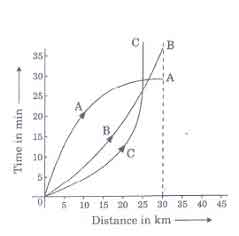 statements :
statements :
1. The race was won by A.
2. B was ahead mark of A up to 25 km
3. C ran very slowly from the beginning.
Which of the statements given above is/are correct ?
(a) 1 only (b) 1 and 2 only
(c) 2 and 3 only (d) 1, 2 and 3
Ans. (b)
Sol: In this graph, lower the line is faster the person will. Thus initially, C was faster, then B took the lead and finally A won the race. Thus statement (1) and (2) are correct and (3) is not.
48. Consider the following figures : What is the missing number?

(a) 7 (b) 8
(c) 9 (d) 10
Ans. (c)
Sol:- 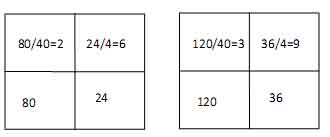
Answer is: 9
49. Study the following figure :
A person goes from A to B always moving to the right or downwards along the lines. How many different routes can he adopt?
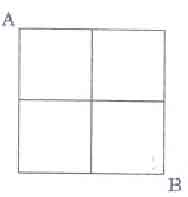
Select the correct answer from the codes given below:
(a) 4 (b) 5
(c) 6 (d) 7
Ans. (c)
Sol: Answer will be 4!/2!x2!= 6 ways.
50. Consider the following figure and answer the item that follows :
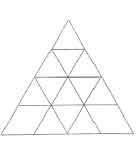
What is the total number of triangles in the above grid ?
(a) 27 (b) 26
(c) 23 (d) 22
Ans. (c)
Sol:
There will be 12 triangles with side 1 unit.
There will be 7 triangles with side 2 units ( 6 straight and 1 inverted)
There will be 3 triangles with side 3 unit.
There will be 1 triangle with side 4 unit.
Thus total number of triangles will be 12+7+3+1=23 triangles
51. A person has only Rs. 1 and Rs. 2 coins with her. If the total number of coins that she has is 50 and the amount of money with her is Rs. 75, then the number of Rs. 1 and Rs. 2 coins are, respectively
(a) 15 and 35 (b) 35 and 15
(c) 30 and 20 (d) 25 and 25
Ans. (d)
Sol: Assume there are x coins of Rs 1 and y coins with Rs 2.
x+y=50
x+2y=75
Thus, x 25 and y=25
52. Three persons start walking together and their steps measure 40 cm, 42 cm and 45 cm respectively. What is the minimum distance each should walk so that each can cover the same distance in complete steps ?
(a) 25 m 20 cm (b) 50 m 40 cm
(c) 75 m 60 cm (d) 100 m 80 cm
Ans. (a)
Sol: We have to check LCM of 40 cm, 42 cm and 45 cm, which comes out to be 2520 cm which is same as 25 m and 20 cm.
53. If a bus travels 160 km in 4 hours and a train travels 320 km in 5 hours at uniform speeds, then what is the ratio of the distances travelled by them in one hour ?
(a) 8 : 5 (b) 5 : 8
(c) 4 : 5 (d) 1 : 2
Ans: (b)
Sol: Speed of Bus is
160Km/4 Hours=40Km/Hours
Speed of train is 320 Km/ 5 Hr=64 Km/Hr
Thus, the desired ratio is 40 : 64 = 5 : 8
54. There are 100 students in a particular class. 60% students play cricket, 30O student play football and 10% students play both the games. What is the number of students who play neither cricket nor football ?
(a) 25 (b) 20
(c) 18 (d) 15
Ans. (b)
Sol:A U B =A+B-A ∩ B
60+30-10=80%
Thus, there are 80 % students who play at least one of the two games and thus, there are 20% students who does not play either of the two games. Hence 20% of 100=20 students does not play either of the two games.
55. A village having a population of 4000 requires 150 litres of water per head per day. It has a tank measuring 20 m ´ 15 m ´ 6 m. The water of this tank will last for
(a) 2 days (b) 3 days
(c) 4 days (d) 5 days
Ans. (b)
Sol: Capacity of tank =20m x 15m x 6m=1800m3 =1800 x 100 lit. (1 m3 =100 Lit) Daily consumption of water =4000 x 150 lit. = 6000000 lit Thus number of days for refill will be 1800 x 1000 lit/ 600000 lit = 3 days
Directions for the following 4 (four) items : Read the following passage and answer the items that follow. Your answers to these items should be based on the passage only.
Passage:
A species that exerts an influence out of proportion to its abundance in an ecosystem is called a keystone species. The keystone species may influence both the species richness of communities and the flow of energy and materials through ecosystems. The sea star Pisaster ochraceus, which lives in rocky intertidal ecosystems on the Pacific coast of North America, is also an example of a keystone species. Its preferred prey is the mussel Mytilus californianus. In the absence of sea stars, these mussels crowd out other competitors in a broad belt of the intertidal zone. By consuming mussels, sea star creates bare spaces that are taken over by a variety of other species. A study at the University of Washington demonstrated the influence of Pisaster on species richness by removing sea stars from selected parts of the intertidal zone repeatedly over a period of five years. Two major changes occurred in the areas from which sea stars were removed. First, the lower edge of the mussel bed extended farther down into the intertidal zone, showing that sea stars are able to eliminate mussels completely where they are covered with water most of the time. Second, and more dramatically, 28 species of animals and algae disappeared from the sea star removal zone. Eventually only Mytilus, the dominant competitor, occupied the entire substratum. Through its effect on competitive relationships, predation by Pisaster largely determines which species live in these rocky intertidal ecosystems.
56. What is the crux of the passage ?
(a) Sea star has a preferred prey.
(b) A preferred prey determines the survival of a keystone species.
(c) Keystone species ensures species diversity.
(d) Sea star is the only keystone species on the Pacific coast of North America.
Ans. (c)
Sol: By giving the example of sea star; the author shows that on removing them; not only mussels are affected but other 28 species also disappeared. Hence the answer ‘c’ is correct Rest are not cogent.
57. With reference to the passage, consider the following statements :
1. Mussels are generally the dominant species in intertidal ecosystems.
2. The survival of sea stars if generally determined by the abundance of mussels.
Which of the statements given above is/are correct ?
(a) 1 only (b) 2 only
(c) Both 1 and 2 (d) Neither 1 nor 2
Ans. (d)
Sol: the dominant species is the keytone species and that is ‘sea star’. Secondly the sea stars do not live exclusively on mussels as their removal resulted in the disappearance of 28 species more. So mussels are not the only ones. Hence both are incorrect.
58. Which of the following is/are implied by the passage?
1. Mussels are always hard competitors for sea stars.
2. Sea stars of the Pacific coast have reached the climax of their evolution.
3. Sea stars constitute an important component in the energy flow in intertidal ecosystem.
Which of the statements given above is/are correct?
(a) 1 and 2 (b) 2 only
(c) 1 and 3 (d) 3 only
Ans. (c)
Sol: Eventually only Mytilus (mussel) the dominant competitor. ‘Sea stars’ are the keystone species which influences both richness of communities and flow of energy. Hence the answer. Answer 2 has not been mentioned in the passage.
59. Consider the following assumptions:
1. The food chains/food web in an ecosystem are influenced by keystone species.
2. The presence of keystone species is a specific characteristic of aquatic ecosystems.
3. If the keystone species is completely removed from an .ecosystem, it will lead to the collapse of the ecosystem.
With reference to the passage, which of the above assumptions is/are valid ?
(a) 1 only (b) 2 and 3 only
(c) 1 and 3 only (d) 1, 2 and 3
Ans. (c)
Sol: Answer 1 is correct ‘the disappearance of 28 species along with mussals.’ 3 is also correct, Disappearance of 29 or more species is no less than collapsing of eco system.
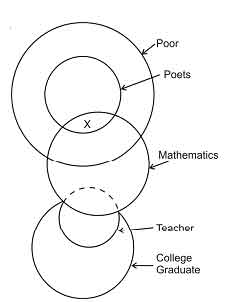 60. Consider the following argument :
60. Consider the following argument :
"In order to be a teacher one must graduate from college. All poets are poor. Some Mathematicians are poets. No college graduate is poor." Which one of the following is not a valid conclusion regarding the above argument?
(a) Some Mathematicians are not teachers.
(b) Some teachers are not Mathematicians.
(c) Teachers are not poor,
(d) Poets are not teachers.
Ans. (b)
Sol: (a) is valid since some mathematicians are poets but no teacher is poet. So, some mathematicians are not teachers.
(b) is invalid as it cannot be concluded.
(c) is valid as teachers are not poor and hence not poets.
(d) is valid as none college graduate is poor and hence not poet.
61. A student on her first 3 tests received an average score of N points. If shell exceeds her previous average score by 20 points on her fourth test, then what is the average score for the first 4 tests ?
(a) N + 20 (b) N + 10
(c) N + 4 (d) N + 5
Ans. (d)
Sol: Total score of 3 tests is 3N. Score on 4th test = N + 20. So, total of 4 tests = 3N + N + 20. Aveage of first 4 tests = (4N + 20)/5 = N + 5
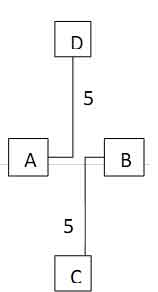 62. In a group of persons, 70% of the persons are male and 30% of the persons are married. If two-sevenths of the males are married, what fraction of the females is single ?
62. In a group of persons, 70% of the persons are male and 30% of the persons are married. If two-sevenths of the males are married, what fraction of the females is single ?
(a) 2/7 (b) 1/3
(c) 3/7 (d) 2/3
Ans. (d)
Sol: Let there be 100 persons. 70 are male and 30 are married. So, 30 are female. Two sevenths of male are married = 70 × 2 / 7 = 20. So, 10 females are also married. So, 20 females are unmarried out of 30. So, fraction of unmarried females = 2/3.
63. The houses of A and B face each other on a road going north-south, A's being on the western side. A comes out of his house, turns left, travels 5 km, turns right, travels 5 km to the front of D's house. B does exactly the same and reaches the front of C's house. In this context, which one of the following statements is correct ?
(a) C and D live on the same street.
(b) C's house faces south.
(c) The houses of C and D are less than 20 km apart.
(d) None of the above
Ans. (c)
Sol: It is clear from the figure that the houses of C and D are less than 20 km apart. Directions for the following 9 (nine) items :
The following 9 (nine) items: (Questions 64 to 72): are based on three passages in English to test the comprehension of English language and therefore these items do not have Hindi version. Read each passage and answer the items that follow.
Passage:I
He walked several miles that day but could not get anything to eat or drink except some dry bread and some water, which he got from cottagers and farmers. As night fell, he slept under a haystack lying in a meadow. He felt frightened at first, for the wind blew awfully over the empty fields. He felt cold and hungry, and was feeling more lonely than he had ever felt before. He, however, soon fell asleep, being much tired with his long walk. When he got up next day, he was feeling terribly hungry so he purchased a loaf of bread with a few coins that he had.
64. When the night fell, he slept
(a) in the open field
(b) under a pile of dry grass
(c) in a farmer's cottage
(d) under a tree
Ans. (b)
Sol: Meaning of ‘haystack’ is pile of dry grass.
65. He soon fell asleep because
(a) he was exhausted
(b) he was all alone
(c) he had not slept for days
(d) he was very frightened
Ans. (a)
Sol: ‘Exhausted’ is the synonym of ‘much tired’.
66. With reference to the passage, consider the following statements :
1. He was walking through the countryside.
2. The cottagers and farmers gave him enough food so that he could sleep at night without feeling hungry.
Which of the statements given above is/are correct ?
(a) 1 only (b) 2 only
(c) Both 1 and 2 (d) Neither 1 nor 2
Ans. (a)
Sol: Cottages and farmers make the site of country side. They did not give him. ‘except some dry bread and some water.’ Hence only answer 1 is correct.
Passage:II
I opened the bag and packed the boots in; and then, just as I was going to close it, a horrible idea occurred to me. Had I packed my toothbrush ? I don't know how it is, but I never do know whether I've packed my toothbrush. My toothbrush is a thing that haunts me when I'm travelling, and makes my life a misery. I dream that I haven't packed it, and wake up in a cold perspiration, and get out of bed and hunt for it. And, in the morning, I pack it before I have used it, and it is always the last thing I turn out of the bag; and then I repack and forget it, and have to rush upstairs for it at the last moment and carry it to the railway station, wrapped up in my pockethandkerchief.
67. When he was going to close the bag, the idea that occurred to him was
(a) unpleasant (b) sad
(c) fantastic (d) amusing
Ans. (a)
Sol: ‘Horrible’ means unpleasant.
68. What makes his life miserable whenever he undertakes travelling ?
(a) Going to railway station
(b) Forgetting the toothbrush
(c) Packing his bag
(d) Bad dreams
Ans. (b)
Sol: His ‘tooth brush’ is the only thing that haunts him.
69. His toothbrush is finally
(a) in his bag
(b) in his bed
(c) in his handkerchief
(d) lost
Ans. (c)
Sol: He runs up and packs it in his ‘pocket handkerchief’.
Passage:III
In spring, polar bear mothers emerge from dens with three month old cubs. The mother bear has fasted for as long as eight months but that does not stop the young from demanding full access to her remaining reserves. If there are triplets, the most persistent stands to gain an extra meal and it may have the meal at the expense of others. The smallest of the litter forfeits many meals to stronger siblings. Females are protective*~*of their cubs but tend to ignore family rivalry over food. In 21 years of photographing polar bears, I've only once seen the smallest of triplets survive till autumn.
70. Female polar bears give birth during
(a) spring (b) summer
(c) autumn (d) winter
Ans. (d)
Sol: By the time they emerge in spring; the cubs are already three months old and thus the time of their birth falls in winter.
71. Mother bear
(a) takes sides over cubs
(b) lets the cubs fend for themselves
(c) feeds only their favourites
(d) sees that all cubs get an equal share
Ans. (b)
Sol: She ignores the rivalry hence lets the cubs fend for themselves.
72. With reference to the passage, the following assumptions have been made :
1. Polar bears fast as long as eight months due to non-availability of prey.
2. Polar bears always give birth to triplets.
Which of the assumptions given above is/are valid ?
(a) 1 only (b) 2 only
(c) Both 1 and 2 (d) Neither 1 nor 2
Ans. (d)
Sol: The reason of their fasting has not been mentioned. For second statement the passage says “If there are triplets...” this means it is not as a rule to give birth to triplets only. Hence both are incorrect.
Directions for the following 8 (eight) items : Given below are eight items. Each item describes a situation and is followed by four possible responses. Indicate the response you find- most appropriate. Choose only one response for each item. The responses will be evaluated based on the level of appropriateness for the given situation.Please attempt all the items. There is no penalty for wrong answers for these eight items.
73. You have been asked to give an explanation for not attending an important official meeting. Your immediate boss who has not informed you about the meeting is now putting pressure on you not to place an allegation against him/her. You would
(a) send a written reply explaining the fact.
(b) seek an appointment with the top boss to explain the situation.
(c) admit your fault to save the situation.
(d) put the responsibility on the coordinator of the meeting for not informing.
Ans. (b)
Sol: Instead of acting under pressure, it is always in tune with the official etiquette to make the top boss aware of any misunderstandings or any issues.
74. A local thug (bad element) has started illegal construction on your vacant plot. He has refused your request to vacate and threatened you of dire consequences in case you do not sell the property at a cheap price to him. You would
(a) sell the property at a cheap price to him.
(b) Go to the police for necessary action.
(c) Ask for help from your neighbours.
(d) Negotiate with the goon to get a higher price.
Ans. (b)
Sol: Instead of acting under the pressure of any goon an aware an active citizen must always try to give the law enforcing agencies a chance to enforce law.
75. You have to accomplish a very important task for your Headquarters within the next two days. Suddenly you meet with an accident. Your office insists that you complete the task. You would
(a) ask for an extension of deadline.
(b) inform Headquarters of your inability to finish on time.
(c) suggest alternate person to Headquarters who may do the needful.
(d) stay away till you recover.
Ans. (b)
Sol: It is better to ask headquarters to decide whether the employee should do the job him-self with extension or ask some-one else to do the job .
76. You are an officer-in-charge for providing basic medical facilities to the survivors of an earthquake affected area. Despite your best possible effort, people put allegations against you for making money out of the funds given for relief. You would
(a) let an enquiry be set up to look into the matter.
(b) ask your senior to appoint some other person in your place.
(c) not pay attention to allegations.
(d) stop undertaking any initiative till the matter is resolved.
Sol: As this is an emergency situation, the first responsibility of any officer is to get the job done and address the situation. Once the crisis is mitigated, the department can be allowed to take care of the proceedings related to any allegations whatsoever.
77. You have been made responsible to hire boats at a short notice to be used for an area under flood. On seeing the price mentioned by the boat owners you found that the lowest price was approximately three times more than the approved rate of the Government. You would
(a) reject the proposal and call for a fresh price.
(b) accept the lowest price.
(c) refer the matter to the Government and wait.
(d) threaten the boat owners about a possible cancellation of the licence.
Ans. (b)
Sol: As this is a crisis situation, the priority must be to make the best out of the available resources, and the avert the crisis. All the other actions and proceedings can wait till the time situation is under control.
78. You are the officer-in-charge of a village administering distribution of vaccine in an isolated epidemic hit village, and you are left with only one vaccine. There is a requirement of that vaccine from the Gram Pradhan and also a poor villager. You are being pressurized by the Gram Pradhan to issue the vaccine to him. You would
(a) initiate the procedure to expedite the next supply without issuing the vaccine to either.
(b) arrange vaccine for the poor villager from the distributor of another area.
(c) ask both to approach a doctor and get an input about the urgency,
(d) arrange vaccine for the Gram Pradhan from the distributor of another area.
Ans. (c)
Sol: This is perhaps the best course of action which could be resorted to at the time.
79. You have taken up a project to create night-shelters for homeless people during the winter season. Within a week of establishing the shelters, you have received complaints from the residents of the area about the increase in theft cases with a demand to remove the shelters. You would
(a) ask them to lodge a written complaint in the police station.
(b) assure residents of an enquiry into the matter.
(c) ask residents to consider the humanitarian effort made.
(d) continue with the project and ignore their complaint.
Ans. (b)
Sol: Option A sounds a very bureaucratic answer. C may not be appreciated by the people, and D may not be the right thing to do. So the answer has to be B, which would defer the matter for the time being till the problem at hand is not brought under control.
80. You, as an administrative authority, have been approached, by the daughter-in-law of an influential person regarding harassment by her in-laws on account of insufficient dowry. Her parents are not able to approach you because of social pressures. You would
(a) call the in-laws for an explanation.
(b) counsel the lady to adjust, given such a circumstance.
(c) take action after her parents approach you.
(d) ask her to lodge a complaint with the police.
Ans. (a)
Sol: An administrative authority must always resort to acting as per the course of law as soon as possible. But in delicate family matters it is always advisable to try to get the situation diffused by arbitration, if possible, by ensuring that either party is not making too much compromises as compared to the other. So A may be the most appropriate course of action.
Study Kit : UPSC - IAS PRE (GS+CSAT) Solved Papers & Test Series
Printed Study Material for IAS (UPSC) General Studies PRE Cum MAINS
Courtesy : UPSC

